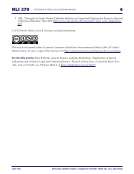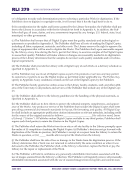RLI 279 22
June 2012 Research Library Issues: A QuarterlLy Report from ARL, CNI, and SPARC
Copyright Risk Management
Authors Guild.12 In considering that lawsuit, however, it is important to distinguish between the legal
arguments being made in the case and the long-term goals of the plaintiffs. The actual legal arguments do
not involve orphan works for the simple reason that no one who holds rights to an orphan work, properly
defined, is a plaintiff in the suit. Although the alleged errors on HathiTrust’s initial list of potential orphan
works received a good deal of attention, none of those works were ever distributed to the public, and the
attention received by the case actually showed that the system of making a list of possible orphan works
available in advance of their actual distribution was very effective. In an ideal situation, the Authors
Guild would work with HathiTrust to be sure that similar errors do not occur in the future.
In a filing made in this lawsuit in February 2012, the Authors Guild has made a unique and troubling
argument about fair use and libraries.13 In essence they suggest that the explicit library exceptions
contained in section 108 of the Copyright Act are the sole provisions for libraries, such that fair use is
unavailable as a defense for library activities. If accepted, of course, this argument would severely curtail
the options for digitizing special collections. But it seems very unlikely that a judge would accept such a
suggestion. For one thing, this position would place libraries at a distinct disadvantage against all other
potential users of copyrighted content, an outcome clearly at odds with the privileged position usually
afforded to libraries by Congress and the courts. Even more decisive, however, is the inclusion in section
108 itself of a provision that reads, “Nothing in this section…in any way affects the right of fair use as
provided by section 107.”14 So while this case bears watching and should be a matter of concern to all
librarians, the clear intention of Congress ought to prevail, so that fair use will remain a significant option
for libraries contemplating digitization projects.
Conclusion
None of the strategies outlined in this article are unique or innovative. The important thing is for
librarians to understand how they can work together to provide a more complete picture of the copyright
situation involved in a proposed digitization project and a more accurate assessment of the potential
risk. Copyright law often seems unmanageably complex, leading librarians to focus too much on a single
aspect of a project and, when that aspect proves inapplicable, to give up the proposed digitization. But the
multifaceted nature of the law, especially its variety of limitations and exceptions, should really be seen
as an invitation to a holistic evaluation that focuses on risk and considers how each facet can contribute
to a risk-reduction strategy. If this is done consistently as digitization projects are undertaken, the risk of
infringement litigation will usually be seen to be much more manageable, and a great deal of unnecessary
self-censorship will be avoided.
1 Prudence Adler, Brandon Butler, Patricia Aufderheide, and Peter Jaszi, “Fair Use Challenges in
Academic and Research Libraries,” December 20, 2010, http://www.arl.org/bm~doc/arl_csm_
fairusereport.pdf.
2 Ibid., 12.
3 Ibid., 11–12.
4 Ibid., 12.
June 2012 Research Library Issues: A QuarterlLy Report from ARL, CNI, and SPARC
Copyright Risk Management
Authors Guild.12 In considering that lawsuit, however, it is important to distinguish between the legal
arguments being made in the case and the long-term goals of the plaintiffs. The actual legal arguments do
not involve orphan works for the simple reason that no one who holds rights to an orphan work, properly
defined, is a plaintiff in the suit. Although the alleged errors on HathiTrust’s initial list of potential orphan
works received a good deal of attention, none of those works were ever distributed to the public, and the
attention received by the case actually showed that the system of making a list of possible orphan works
available in advance of their actual distribution was very effective. In an ideal situation, the Authors
Guild would work with HathiTrust to be sure that similar errors do not occur in the future.
In a filing made in this lawsuit in February 2012, the Authors Guild has made a unique and troubling
argument about fair use and libraries.13 In essence they suggest that the explicit library exceptions
contained in section 108 of the Copyright Act are the sole provisions for libraries, such that fair use is
unavailable as a defense for library activities. If accepted, of course, this argument would severely curtail
the options for digitizing special collections. But it seems very unlikely that a judge would accept such a
suggestion. For one thing, this position would place libraries at a distinct disadvantage against all other
potential users of copyrighted content, an outcome clearly at odds with the privileged position usually
afforded to libraries by Congress and the courts. Even more decisive, however, is the inclusion in section
108 itself of a provision that reads, “Nothing in this section…in any way affects the right of fair use as
provided by section 107.”14 So while this case bears watching and should be a matter of concern to all
librarians, the clear intention of Congress ought to prevail, so that fair use will remain a significant option
for libraries contemplating digitization projects.
Conclusion
None of the strategies outlined in this article are unique or innovative. The important thing is for
librarians to understand how they can work together to provide a more complete picture of the copyright
situation involved in a proposed digitization project and a more accurate assessment of the potential
risk. Copyright law often seems unmanageably complex, leading librarians to focus too much on a single
aspect of a project and, when that aspect proves inapplicable, to give up the proposed digitization. But the
multifaceted nature of the law, especially its variety of limitations and exceptions, should really be seen
as an invitation to a holistic evaluation that focuses on risk and considers how each facet can contribute
to a risk-reduction strategy. If this is done consistently as digitization projects are undertaken, the risk of
infringement litigation will usually be seen to be much more manageable, and a great deal of unnecessary
self-censorship will be avoided.
1 Prudence Adler, Brandon Butler, Patricia Aufderheide, and Peter Jaszi, “Fair Use Challenges in
Academic and Research Libraries,” December 20, 2010, http://www.arl.org/bm~doc/arl_csm_
fairusereport.pdf.
2 Ibid., 12.
3 Ibid., 11–12.
4 Ibid., 12.
























